Blog
Archives
.
. . from 2012 to current
ISLE
OF WIGHT
29 JUNE to 3 JULY - 2015
My wife and I have
been away on the Isle of Wight for the past week,
mainly looking after two very lively grand daughters.
Here are a couple of wildlife observations I managed
to get which are of interest.
Sea
Slater
While we were
all walking along the promenade of West Cowes the
girls spotted a large wood louse type creature
scuttling over the concrete foreshore towards the sea.
It was much larger than the common wood louse one
finds in gardens and it moved much faster.
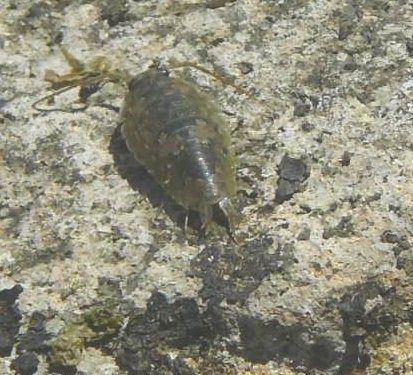
I had a look in my
Collins Guide to Insects by Chinnery when I got home
and located it as Sea Slater - Ligia
oceanica. Wood lice are land-living
crustaceans of the order Isopoda and have seven pairs
of walking legs. Most are scavengers among dying
vegetation as are Sea Slaters on the rocky shores.
Water
Bent
I was on the
look out for any pavement grasses like I recently
found in Emsworth and I found a good growth of Water
Bent in a neglected front garden in St Mary's Road
Cowes.
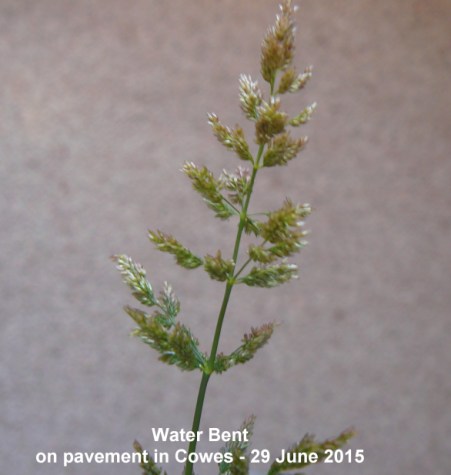
The Isle of Wight
Flora describes Water Bent (Poypogon viridis)
as 'A rare but increasing casual grass of waste
ground'. This prompts me to send the record to the
Isle of Wight recorder.
MORE
TO COME from the island
EMSWORTH
NEWS OVER THE PAST WEEK
JUNE 29 to JULY 3
Here are some
observations and photos I have received while I have
been away on the Isle of Wight.
Sparrowhawk
Tony Wootton sent me this cracking photo of a superb
female Sparrowhawk taken by his friend Jill Gask. It
looks to me like a female. It was taken in Gill's
garden in North Emsworth, interestingly not far from
Patrick Murphy, perhaps the same bird that he
sometimes gets in his garden.
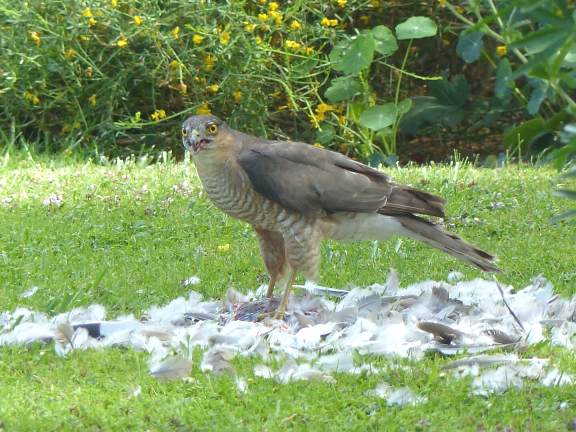
Gill added "It was
quite fascinating to watch - first the small feathers,
then the larger ones, then finally the meal itself.
All that was left was feathers, plus one foot with a
bone attached - no other bones at all, no carcase! All
in about half an hour. It was quite wary, looking
round all the time. It was certainly a feast,
Brook
Meadow
Malcolm
Phillips is back from holiday and sent a few photos he
got on Brook Meadow. Marbled Whites are everywhere at
present, but what beauties they are.
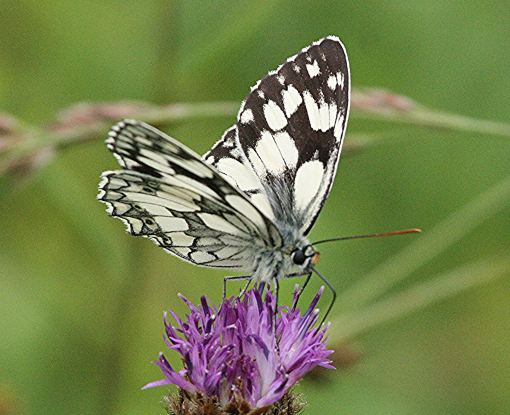
Large Skipper - the
first of the year on Brook Meadow. Later than usual.
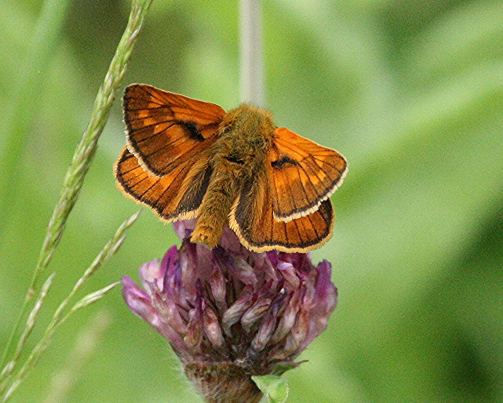
5-spot Burnet Moth -
very common this year. This is probably the
Narrow-boardered variety.
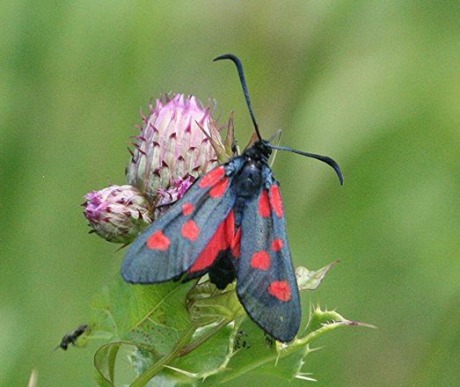
Hampshire
Farm
Chris Oakley
has seen Marbled Whites and Meadow Browns on the
Hampshire Farm site, plus a couple of Large Skippers
which have just started to emerge. Chris watched a
dramatic aerial combat between a Buzzard and a
Sparrowhawk. He thinks there are a second pair of
Skylarks nesting out on the main meadow.
Chris is meeting a lot of people who are very positive
about the site and its wildlife and looks forward to
building a following and forming a conservation group.
Chris is also writing some Nature Notes for an
information board that will be erected by HBC . All
this is very good news.
Hollybank
Woods
During a visit
to the woods, Francis Kinsella saw a group of 5 or 6
juvenile Nuthatches, being very noisy and lively in a
tree.
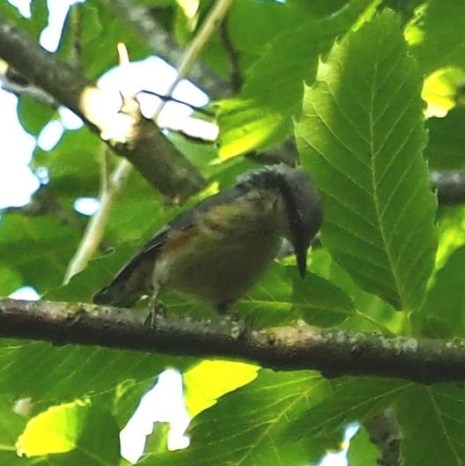
House
Martins
David Perks
reported quite a few House Martins flying over the
pond at Hampshire Farm and over Westbourne in the
evenings. But he has only located two nests, No. 3
Lark Close in Westbourne. He and David Minns have been
carrying out the BTO House Martin survey at Chalton
and Walberton, but numbers of both birds and nests in
both squares are low - only 3 nests in total so far.
Mystery
bird
Dr
Collings-Wells (my local GP) sent me this photo taken
by a friend in his kitchen on the downs north of
Hambledon.
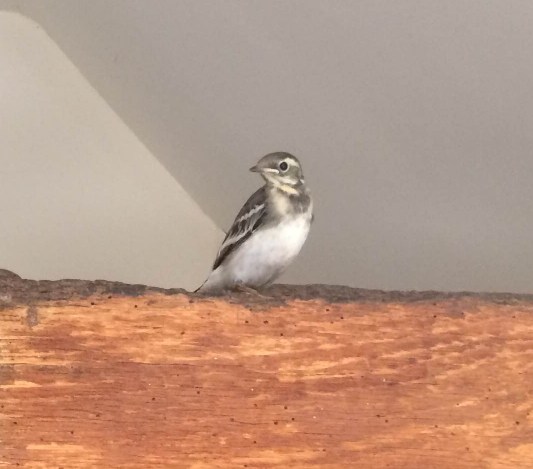
My guess is a
juvenile Meadow Pipit which certainly would be
fairly common in that habitat. I assume this bird has
yet to acquire the characteristic streaking on its
flanks and underparts of an adult Meadow Pipit, hence
the clear and pale underparts. The wing bar and pale
edge to the wing are, however, distinctive of a Meadow
Pipit. The head markings are probably the start of the
submoustachial stripe and supercilium. But I am far
from certain so if anyone else has any ideas then
please let me know.
SUNDAY
JUNE 28 - 2015
Mute
Swan News
A morning walk
around the drained town millpond found the Mute Swan
family at the far southern end where the water remains
reasonably deep. The 5 cygnets look very healthy and
are growing well. The white 'Polish' cygnet stands out
clearly from the other grey ones.
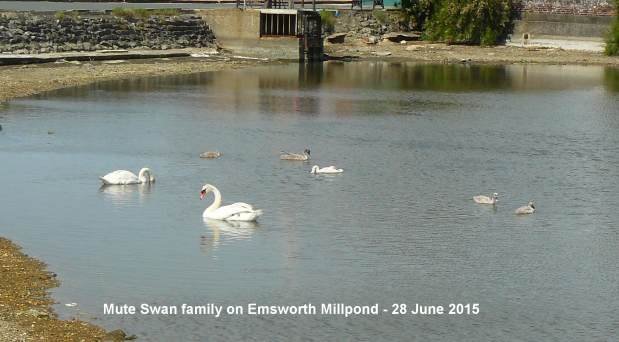
Distorted
catkin
The first
willow tree on west side of the pond along Bath Road
has a number of strange growths on its twigs which I
do not recall ever having seen before. The one I
picked to take home for examination was a conical
shape, though there were many different shapes. My one
is about 10cm tall and 5cm across the base.
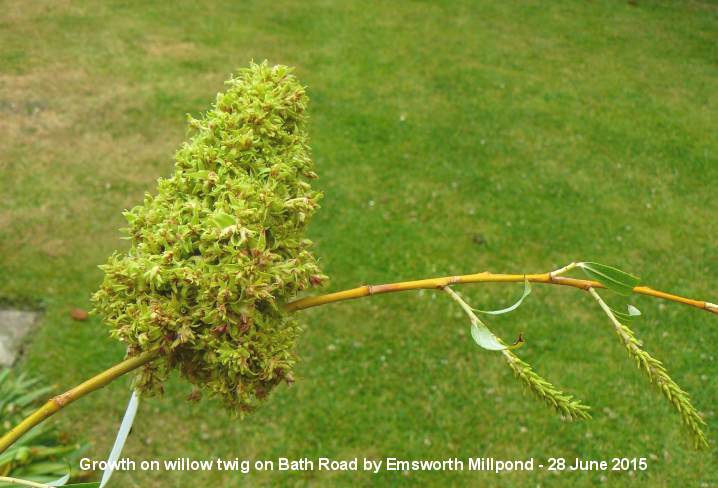
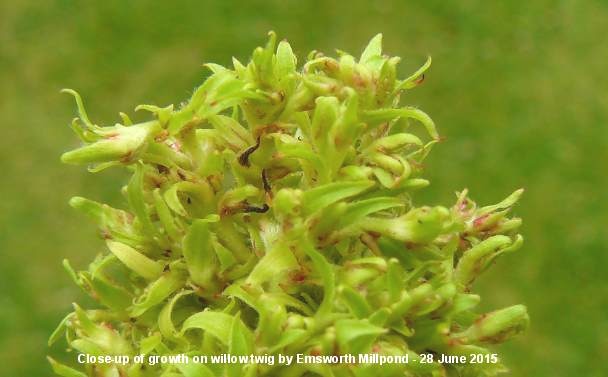
The growth appears to
be coming from the twig where a female catkin should
be. There were a number of normal female catkins on
the same twig. I assume this is some sort of
abnormality in the growth of the catkins, possibly due
to a gall insect. I searched in vain through the
images on Google for anything like it. Does anyone
know what these growths might be due to?
Bridge
Road Wayside
Walking back
through Bridge Road car park I spotted the first
Sulphur Cinquefoil of the year growing in much
the same spot as in previous years, just south of the
Goat Willow at Grid Ref: SU 7473 0604. Sorry about the
pic. My Lumix FZ8 does not like yellow!
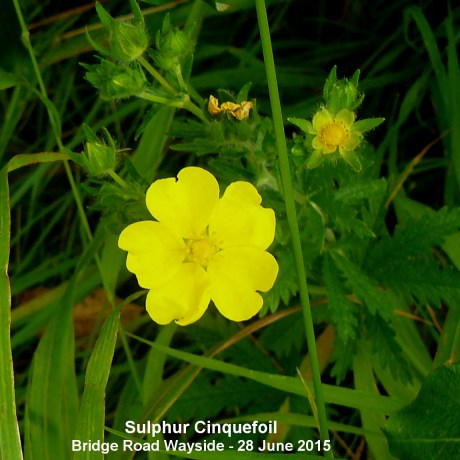
The yellow flowers are
larger than those of the more common Creeping
Cinquefoil and the leaves are also quite different. As
Sulphur Cinquefoil is an introduced species,
originally the Bridge Road plant might have been a
garden escape. However, it seems to be well
established on this site as it has been recorded here
each year since 2010.
Bulrushes are also flowering in the stream; I
thought we might have lost them in the last stream
clearance.
Kingfisher
sighting
Ralph Hollins
responded to yesterday's report from Pam Phillips of
an early Kingfisher on Brook Meadow with the following
comment:
"Your report of the first Kingfisher to return to
Brook Meadow on June 27 co-incides with a report of
two 'early returning' birds at Christchurch Harbour
also on June 27 - these are the first reports I have
seen this summer.
I have always understood that a pair of Kingfishers
will have several broods of young each year, chasing
the young of each brood out of the nest area as soon
as they fledge, and it is these juveniles which are
the first to reach the coast (many of them perish en
route).
If you have any more sightings in the near future I
would be interested to know if they are juveniles -
they can be distinguished by having dull coloured feet
(adults have bright red feet) and by having a tiny
white spot at the tip of the bill."
Brook
Meadow film
I met a young photographer named Taylor Harvey Brigden
on June 24th making a film on Brook Meadow for his
portfolio. I asked him at the time to send me a link
to the finished product which he has now done. The
film is a short 1 minute episode on the meadow called
'Lunch Break' with Taylor walking through the meadow
and settling on the main seat to read a book. Here is
the link to the YouTube video . . . https://www.youtube.com/watch?v=XOtESlRjlec&feature=youtu.be
Langstone
Mill Pond
Peter
Milinets-Raby had a very brief 45 minute visit to
Langstone Mill Pond this morning at 11am.
Highlights:
Pond: Mute Swan family back on the pond (not
present yesterday) with 6 cygnets. The male was being
very aggressive towards virtually everything - dogs,
people, Coot, kids feeding the ducks and terrorising
the hell out of a Mallard family with four ducklings,
chasing them on several occasions into the reed bed
and persistently pursuing them! This does not bode
well for the other tiny ducklings discovered?
Chiffchaff singing, 3 singing Reed Warbler (odd birds
seen), Pair of Reed Bunting seen, Stock Dove,
Tufted Duck pair with 5 very tiny ducklings
days, if not day old! (Just like last year on 20th
July - these tiny creatures were only seen the once
and with the Mute Swans being as aggressive as they
were today, I fear these ducklings will not survive or
be quickly relocated somewhere?). The female Tufted
Duck was only seen very briefly with her brood before
she vanished into the quieter corners of the
pond!)
Off shore: Lapwing, Great Crested Grebe, 4+ Med
Gulls.
Stopped off briefly to count the gulls on the factory
roof at the rear of the Colt factory (New Lane,
Havant). Surprised to discover 10 Lesser
Black-backed Gulls present all attending chicks (5
pairs) and 37 Herring Gulls (minimum of 18 pairs -
hard to count). And a Great Black-backed Gull which
may of had a nest, but not sure). Here is a Lesser
Black-backed Gull with chick.
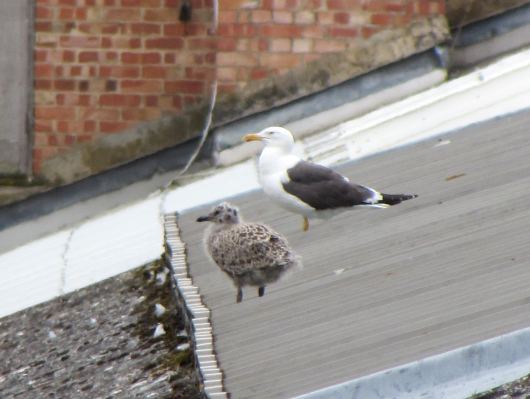
One of the Lesser
Black-backed Gulls had a huge black ring on one of its
legs with white numbers/letters on it, but of course
the join of the ring was showing towards me and the
photos are so inconclusive to what the digits' are! An
educated guess is "P 1 R"
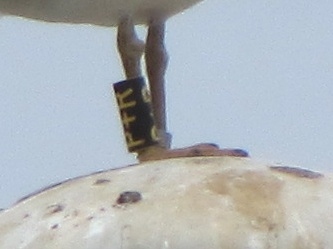
SATURDAY
JUNE 27 - 2015
Wildlife
Watch visit Brook Meadow
Pam Phillips,
David Search and myself (Brian Fellows) spent a very
enjoyable and productive morning on Brook Meadow in
the company of 17 children and their parents who were
members of the Havant and Portsmouth Branch of the HWT
Wildlife Watch Group led by Liz Roffe and June
Williams. The weather was fine, warm and sunny, just
the ticket for wildlife watching and the children lost
no time in getting stuck in. What fun they had and
what a great pleasure it was to see them digging and
delving into the long grasses to reveal their hidden
delights. Here are some of the best wildlife finds.
Marbled
White butterfly - found by young Travis was a first
for Brook Meadow this year.

Bug
hunting - with David Search and some of the
children

Meadow Grasshoppers
were the most frequently caught insects during the
morning. They were mostly instars, ie young
grasshoppers yet to reach full maturity. The children
also found a Roesel's Bush-cricket - another
first of the year on Brook Meadow. We did not manage a
photo, so here is one I took earlier. Note the
distinctive pale stripe around the pronotal flaps.

One of
the parents makes a good find of a Ringlet butterfly
and is rightly delighted with it.
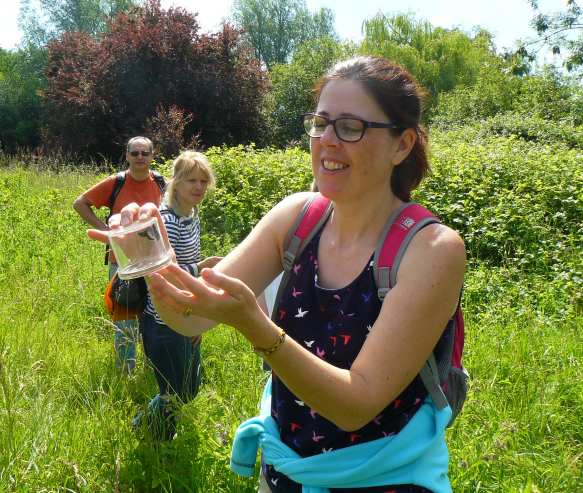
We found both Common
Frog and Common Toad - the latter identified from its
warty skin and the fact that it tried to crawl away
rather than jump as a Frog would have done.
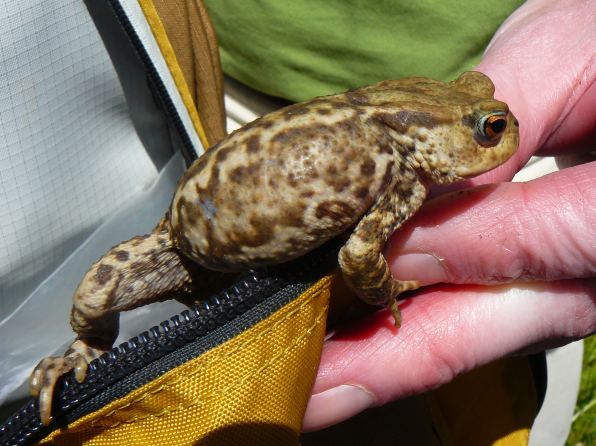
A 'Nursery-web
spider' (Pisaura mirabilis) was a really
interesting catch in the south eastern corner of the
meadow. The photo shows the female spider carrying a
cocoon full of eggs in her fangs. When the eggs are
about to hatch, she attaches the cocoon to vegetation,
spins a silken tent over it and stands guard until the
young spiderlings disperse.
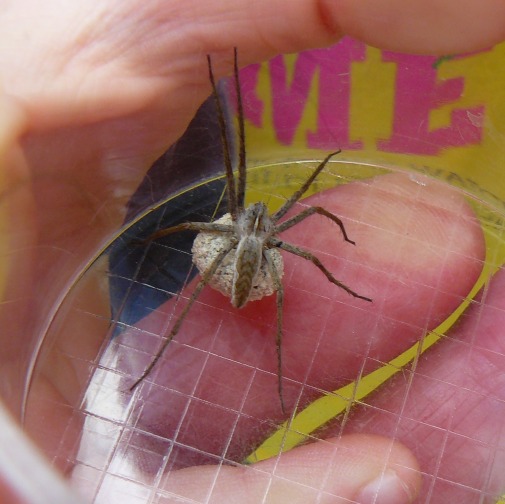
For
the full report and more photos go to .
. .
http://www.brook-meadow.hampshire.org.uk/bm-diary-2015b.html
Other
Brook Meadow news
Pam Phillips
saw what was probably the first post-breeding
Kingfisher on the west side of the meadow at
7.30am this morning. Pam also reported a Moorhen
family with 4 chicks near the south
bridge.
Dave Lee had a
sighting of what he was fairly sure was a Weasel
yesterday evening. Dave was walking nhis dog and
the Weasel, instead of running away, became
aggressive, especially when he attempted to get close
to take a photo. He said "It came at me with a wide,
gaping mouth eventually moving at a leisurely into the
long grass." Dave got a photo, but has mislaid his
cable to transfer it to his PC, so we shall have to
wait.
Hampshire
Farm
Things are
hotting up on Hampshire Farm. Chris Oakley was over
there this afternoon and got a couple of interesting
shots so it was well worth it. He got his first
sighting over there of a female Beautiful
Damselfly. The female Beautiful Demoiselle can be
distinguished from the female Banded Demoiselle by its
broader wings which have a brownish tint.

Chris also had
female Emperor dragonfly hiding in the grass
from the wind. We have not had one on Brook Meadow as
yet this summer.

Chris also snapped
this yellow and black insect which he thinks is a form
of Sawfly but can't be sure. I don't have much idea
either, though I would have gone for one of the
Ichneumon flies e.g. Amblyteles.
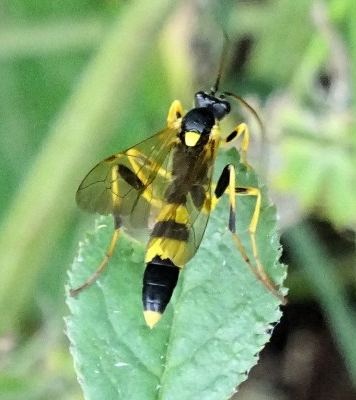
Other
local news
Patrick Murphy
had an unusual visitor to his garden in North Emsworth
in the form of a male Beautiful Demoiselle.
This is the first Demoiselle of any sort I have heard
of in a garden. They are fairly common on Brook Meadow
and Chris Oakley had a female on the Hampshire Farm,
but not gardens until now!

Tony Wootton has had
three or four sightings of Stag Beetles flying
over the last few evenings. Here is the only one he's
managed to find, a female, a male is proving more
difficult.
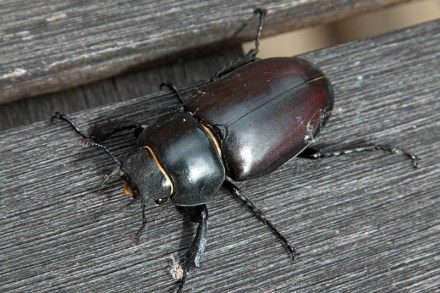
Eric Eddles who lives near Baffins Pond in Portsmouth
found these insects on his garage yesterday, a
Harlequin ladybird larva and a new moth for him
namely a Light Arches.
FRIDAY
JUNE 26 - 2015
Swifts
A good 10
Swifts were flying over the houses in Bridge Road at
about 11.30 this morning. This is the most I have seen
at any one time this summer. They were probably family
parties, soon to be screaming around the houses,
maybe.
Brook
Meadow
This morning's
stroll through Brook Meadow brought a few interesting
observations.
A Small Tortoiseshell was the first for a
while, most likely indicating emergence of the summer
brood. Maybe at last we shall be seeing more
butterflies around the reserve and the town. The Small
Tortoiseshell was surprisingly tricky to photograph as
it hardly stayed still for more than a few seconds
before fluttering off and settling again with wings
closed.
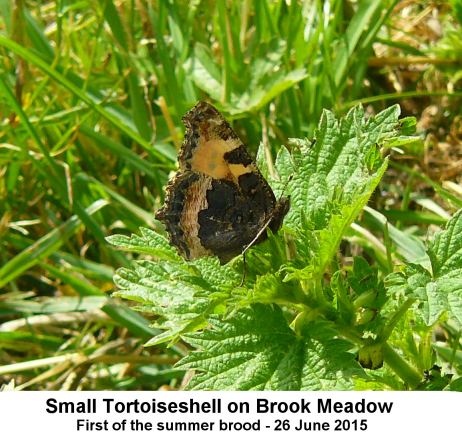
Another good find was
my first Black Bent grass (Agrostis
gigantea) in the small open area towards the
southern end of the Bramble path on the south meadow,
which is where I have found it in previous years.
Black Bent certainly lives up to its scientific name -
it is a giant among Bents. The sample I pulled up was
a good 80cm tall and the panicle was 18cm. Its ligules
are long, blunt and toothed. Looking closely at the
panicles one can see that the branchlets and pedicles
tend to cluster at the tips of the main branches.
A tussock of Remote Sedge is now showing very
well near the start of the path through Palmer's Road
Copse from the south bridge. It has bright green
leaves, well spaced spikelets and very long leaf-like
bracts which are the key feature of this attractive
sedge. This is the only reliable place that it grows
on the Brook Meadow site.
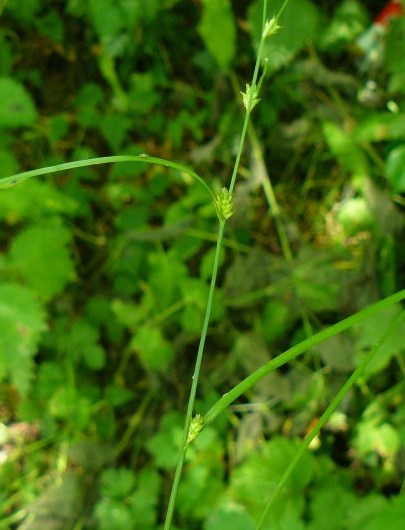
A Whitethroat
is still singing at the south end of the Bramble
path in the south meadow.
Mystery
giant mustard
Martin Rand
suggested another identification to Black
Mustard (Brassica nigra) which Ralph
Hollins suggested for the huge plant that Chris Oakley
found on the wayside on the corner of Redlands Lane
and Nursery Close in North Emsworth.
Martin thinks it might be Hoary Mustard
(Hirschfeldia incana) which, he says, is a much
commoner plant nowadays than Black Mustard in the
coastal regions of Hampshire. Martin says we need to
check to see whether any of the beaks to the fruit
have seeds in them: if seeds are present then it is
Hirschfeldia; if there are no seeds in a narrow
beak then it is Brassica nigra. Chris Oakley had
another look at the plants today and found the larger
plant had not yet set seed but one of the smaller ones
had.
I decided to have a
look for myself and to compare the Nursery Close
plants with the Black Mustard that we know have been
growing on the Emsworth Marina seawall for years. The
two plants certainly look quite different in general
appearance with the Nursery Close ones generally
standing tall and straight, where the Black Mustards
on the marina seawall are far more bushy and lower.
The flowers of the Nursery Close plants are also much
larger than those on Nursery Close. However, both
these differences could be due to the very different
habitats they are growing in.
Here
are the Nursery Close plants with the largest one at
the front.

Now for the seed pods.
The pods on the Black Mustard on the marina seawall
are well developed, though, as Chris says, only one of
the Nursery Close plants has developed pods as yet. I
put both specimens of both pods under the microscope
and took the following photo which shows the Black
Mustard on the left and the mystery mustard on the
right. Clearly, they differ in general appearance,
though this might be due to their different states of
maturity. I am not sure what is the significance of
the cluster of pollen (?) at the end of the pods, but
there is no sign of any seeds in either of them. But
clearly, we must wait until the Nursery Close pods
develop into full maturity.
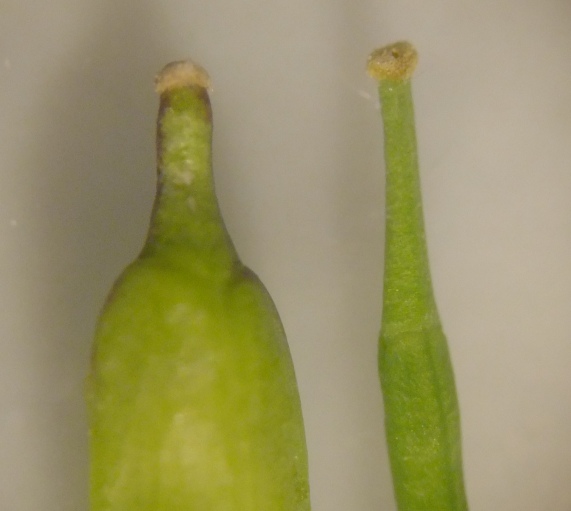
THURSDAY
JUNE 25 - 2015
Small-flowered
Crane's-bill
My main target
this morning was to try to confirm the identification
of the crane's-bill with very small lilac flowers that
I found on the Washington Road path wayside on Tuesday
23 June. The plants are on the west side of the path
that leads through to the Recreation Ground just
beyond the large metal gates. Grid Ref: SU 74612
06370. They are straggling over the edge of the path
and most of the flowers have gone over. I collected a
couple of specimens of the smaller flowered
crane's-bill along with some Dove's-foot Cranesbill
for comparison. The Dove's-foot Cranesbill can be
found further along the path just beyond the A27
underpass. The two plants certainly look quite
different, particularly in the size and brightness of
the flowers. The flowers of Dove's-foot Cranesbill are
large and bright compared with the smaller flowered
crane's-bill.
I had a look at the
pedicles (flower stalks) with the microscope at home
and found those of Dove's-foot Cranesbill had both
short and long hairs. The smaller flowered
crane's-bill had mostly short hairs, though it did
have a few straggly long hairs.
Dove's-foot
Cranesbill on the left . . . . Small-flowered
Crane's-bill on the right
I was not entirely
convinced by the hairs on the pedicles, but when I
looked at the inside of the flowers the difference
between the two plants was much clearer. The smaller
flowered crane's-bill flowers had only 5 stamens with
anthers; the other 5 stamens had no anthers. I looked
at several flowers and they were all the same. In
contrast the flowers of the Dove's-foot Cranesbill had
all 10 stamens with anthers.
Dove's-foot
Cranesbill on the left . . . . Small-flowered
Crane's-bill on the right
This evidence provided
much better proof that that the smaller flowered
crane's-bill plants I found on June 23 were
Small-flowered Crane's-bill.
Emsworth
Millpond
A walk round
the millpond this morning found the Mute Swan
family with their 5 cygnets in the low water
channel near the Slipper Sailing Club. The pond is
very dry at present and there is no chance of their
getting anywhere near the nest without a very long
walk.
I was pleased to see the Maidenhair Spleenwort
fern still looking good on the wall of the
Waterside Church in Bath Road along with a good growth
of the more common Wall Rue.
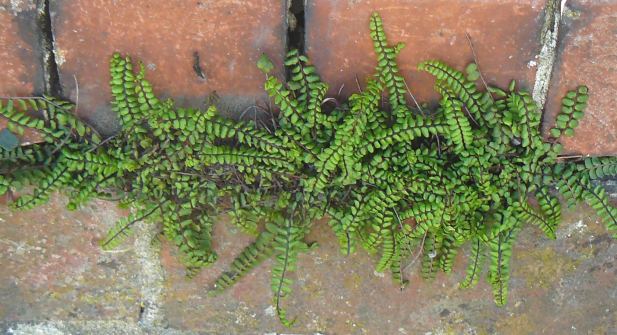
The bright yellow
flowers of Biting Stonecrop cannot be missed on
the east wall of the millpond. I am pleased to see the
general tidying-up of 'weeds' around the pond did not
affect this plant that comes up here every year. How
could anyone wish to get rid of such a beautiful
plant? It gets its name from the peppery 'biting'
taste of its leaves, though I have not attempted to
confirm this.

Brook
Meadow
Meadowsweet is
now in flower on the east side of the north meadow
just south of Beryl's seat with lots more to come. We
need to have a real mass of flowers to get the full
aromatic effect.

Railway
Wayside
This afternoon
I had a walk around the wayside to the north of
Emsworth Railway Station. Actually, most of the plants
can be readily viewed from the access ramp without
having to clamber over or through the railings, which
I did.
Several plants of
Hoary Willowherb are growing close to the ramp
and show up well with their small pink flowers and
densely hairy stem and leaves giving the whole plant a
grey (hoary) appearance. Hoary Willowherb is generally
a narrow upright plant in which the leaves remain
fairly close to the stem. The stigmas of Hoary
Willowherb flowers are in fact 4-lobed, like the
larger Great Willowherb, but appear club-shaped in
this photo as they are held upwards.

The large bright pink
flowers of Great Willowherb are also out on
this wayside and soon should be out generally. There
is one in full flower just inside the wall of the path
leading to the station. This is the most common of the
willowherbs in the local area and grows in abundance
of Brook Meadow.
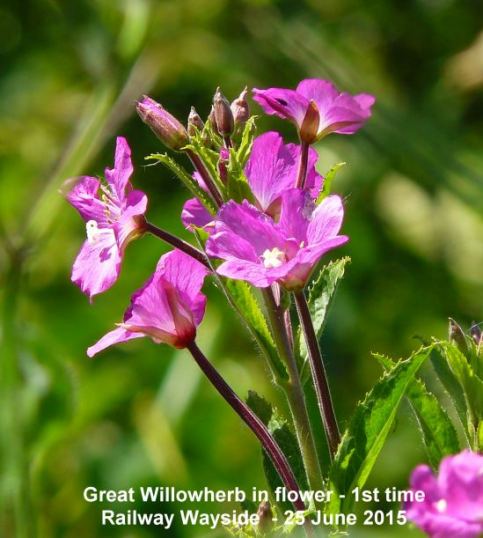
I could not find any
Marsh Woundwort on the eastern section of the
wayside where it has been prolific in previous years,
but the area is now covered with a layer of brambles
which cannot help. It would be good to find some way
of clearing the bramble to give the other plants a
chance. I did find a few Marsh Woundwort plants
starting to open their flower spikes about half way
along the wayside near the conservation notice, but
very few in comparison with previous years. In Year
2012 we had over 200 Marsh Woundwort flower spikes on
the wayside.
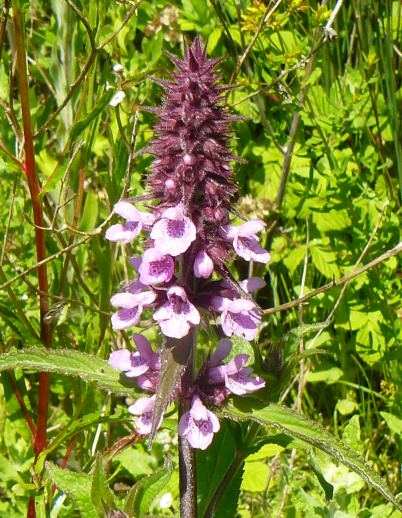
I was surprised to
find a few plants of Wild Basil flowering in
the eastern section of the wayside near the wall of
the entrance to the station. These were a first for
the wayside. I assume these got here under their own
steam and were not planted.
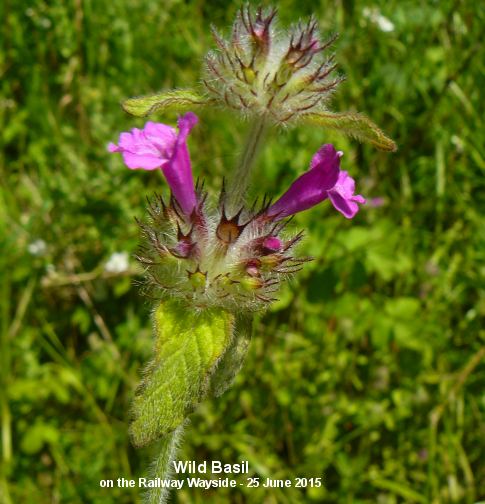
There is an excellent
show of Common Ragwort flowers, but no Cinnabar
caterpillars as far as I could see. Both the common
thistles are now in flower, Creeping Thistle
and Spear Thistle, the latter of which is
abundant on this wayside.
Other plants in flower
were Perforate St John's-wort, Common Knapweed,
Selfheal, Tufted Vetch, Yarrow, Wild Carrot, Creeping
Bent grass, Hedge Bedstraw and Lesser Trefoil.
So far this year I have logged 101 species of plant on
the Railway Wayside from a total list of 171 dating
back to 2012. Many of the plants that we found in the
first year with the new input of soil for the ramp
have not been seen again.
New
Brighton Road Junction
I had a quick
look at this prominent wayside at the junction of two
main roads out of Emsworth. My first impression was
how much Stone Parsley had taken over the site.
It used to be confined to the back of the wayside near
the fence, but now it is everywhere and must be seen
as the dominant plant of the wayside. There is a large
bush of it growing around the road sign to Westbourne.
It is amazing to think that Stone Parsley was a valued
meadow indicator when we first began surveying Brook
Meadow in the Year 2000.
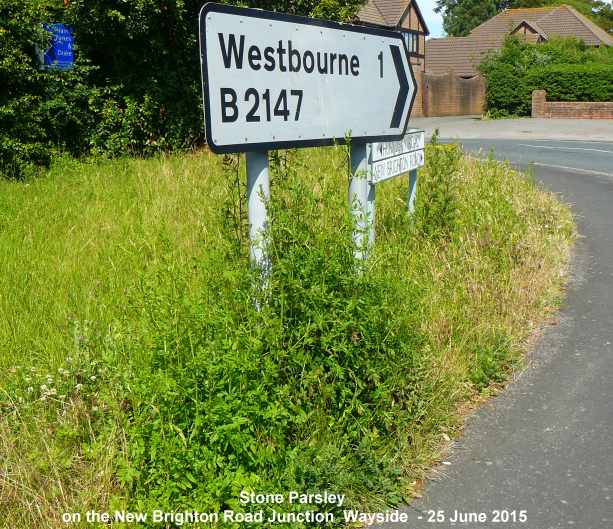
There has been no sign
of the Bee Orchids that we have had on this wayside in
2012 and 2014.
Oversized
Plantain
During my
visit to the Hampshire Farm open space on June 23 I
found some of the oversized Plantains that Chris
Oakley had previously noticed and puzzled over.
Personally, I had no idea what they were except they
were clearly plantains in everything but size. So, I
sent a photo to BSBI recorder Martin Rand who replied
that he thought it was a teratological condition
(probably a genetic abnormality), which is quite
common in Plantains.
Normal
Ribwort Plantain on the left . . . . teratological
plantain on the right

I had to look up the
meaning of teratological on Google. It told me that
"Teratology is the study of abnormalities of
physiological development. It is often thought of as
the study of human congenital abnormalities, but it is
broader than that, taking in other non-birth
developmental stages, including puberty; and other
non-human life forms, including plants."
Sea
Fern Grass
I sent a
specimen of the pavement grass from outside No 35 St
James Road to Martin Rand and his verdict was that it
was Sea Fern Grass (Catapodium marinum) rather
than Fern Grass (Catapodium rigidum). Martin
added that it has rather short lemmas for this
species, but the upper glume length is right and the
inflorescence (although not decisive in itself) looks
good too. So I will submit this as a record to Hants
Plants for tetrad SU70M. Many thanks to Philip
Marshall from Todmorden for identifying this grass as
Sea Fern Grass initially.
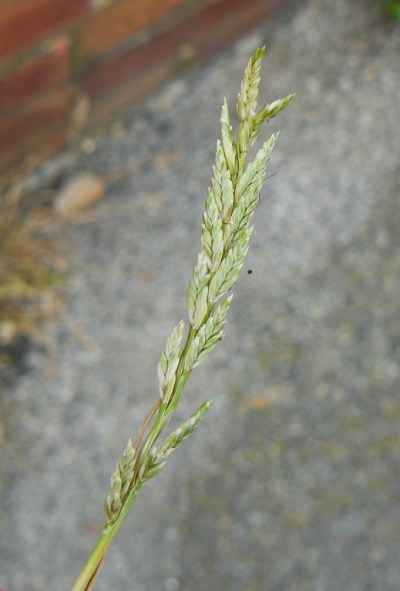
For
earlier observations go to . . June
15-24
.